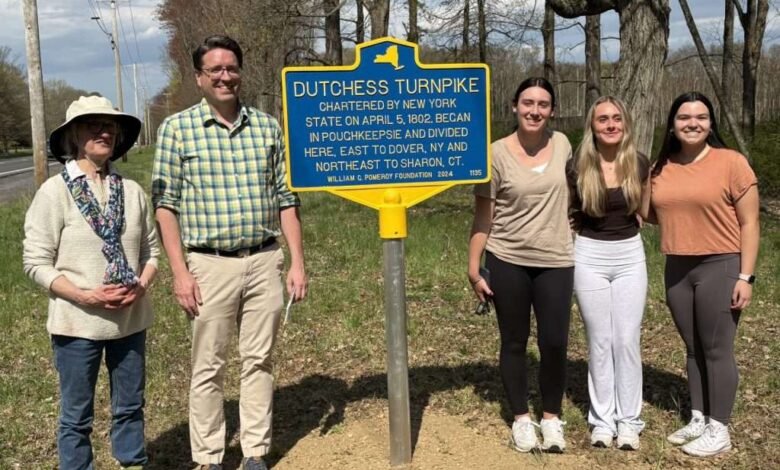The Dutchess Turnpike – New York Almanack


 In early New York and New England, rivers offered the most accommodating transportation options available to settlers, notably the Hudson and Connecticut Rivers. Travel between these rivers began on foot trails created by native people. These were improved to accommodate military and commercial traffic by governments and by entrepreneurs chartering turnpikes to exploit the tolls.
In early New York and New England, rivers offered the most accommodating transportation options available to settlers, notably the Hudson and Connecticut Rivers. Travel between these rivers began on foot trails created by native people. These were improved to accommodate military and commercial traffic by governments and by entrepreneurs chartering turnpikes to exploit the tolls.
A new historical marker near Millbrook in Dutchess County identifies one such route: the Dutchess Turnpike.
Chartered by New York State on April 5th, 1802, the Dutchess Turnpike was an important route of transportation that connected Poughkeepsie with Dover, New York and Sharon, Connecticut, which allowed produce and agricultural goods to make their way to New York City via the Hudson River.
It connected the Poughkeepsie, Fishkill and Rhinecliff landings on the Hudson River to points east on the Housatonic and Connecticut Rivers.
The history of the Dutchess Turnpike, along with its significance, is detailed in the by a Dutchess County Historical Society published article by Alson D. Van Wagner, “The Turnpikes of Pleasant Valley”:

 “The act is quite specific in regard to election and term of officers, taking of land, settlement techniques between turnpike corporation and landowner, etc. The road was to be at least 4 rods wide (66 feet) ‘except where valuable buildings interfere,’ 28 feet ‘of which shall be bedded with stone, gravel or stone pounded, or other small hard substance…rising towards the middle by a gradual arch, and not so steep… as that a wagon… loaded with hay will not be overturned by moving on any part…; and the waterways on each side…as that in the times of snow they will form a good path for sleds.” Furthermore, the turnpike must be kept in good repair.”
“The act is quite specific in regard to election and term of officers, taking of land, settlement techniques between turnpike corporation and landowner, etc. The road was to be at least 4 rods wide (66 feet) ‘except where valuable buildings interfere,’ 28 feet ‘of which shall be bedded with stone, gravel or stone pounded, or other small hard substance…rising towards the middle by a gradual arch, and not so steep… as that a wagon… loaded with hay will not be overturned by moving on any part…; and the waterways on each side…as that in the times of snow they will form a good path for sleds.” Furthermore, the turnpike must be kept in good repair.”
In 1869, the ownership of the portion of the Turnpike within Poughkeepsie (later Main Street) was surrendered to the City. A few decades later, the Dutchess Turnpike was made a public road. Now, the former Turnpike is part of US Route 44.
The site of the historical marker is where the Dutchess Turnpike split into its Dover and Sharon branches. The Marker was funded by the William G. Pomeroy Foundation and was a class research project of students in Robert McHugh’s Arlington High School History class.
Read more about early roads and turnpikes in New York.
Photo: (L to r) are Millbrook Historical Society Secretary Alison Meyer, Society President Robert McHugh, and Arlington High School students Cora O’Hare, Ruby Carman, and Samyra Cicala.
Source link




